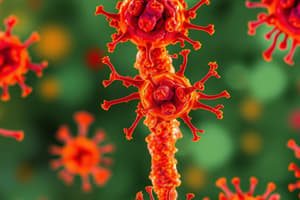Podcast
Questions and Answers
Which enzyme is specifically associated with the breakdown of pectin in fruits?
Which enzyme is specifically associated with the breakdown of pectin in fruits?
- Protease
- Pectinase (correct)
- Amylase
- Cellulase
What type of linkages are found in the structure of cellulose?
What type of linkages are found in the structure of cellulose?
- γ-1,6-linkages
- β-1,4-linkages (correct)
- α-1,4-linkages
- δ-2,4-linkages
Which bacteria is known to cause soft rot in celery and carrots?
Which bacteria is known to cause soft rot in celery and carrots?
- Clostridium botulinum
- Erwinia carotovora (correct)
- Lactobacillus plantarum
- Bacillus subtilis
Which of the following fungi is associated with decay in citrus fruits?
Which of the following fungi is associated with decay in citrus fruits?
What is the main composition of pectin found in fruits?
What is the main composition of pectin found in fruits?
Which factor is NOT directly mentioned as affecting microbial growth?
Which factor is NOT directly mentioned as affecting microbial growth?
What is the primary by-product produced by lactic acid bacteria during fermentation?
What is the primary by-product produced by lactic acid bacteria during fermentation?
Which microorganisms are primarily responsible for spoiling proteins in an anaerobic environment?
Which microorganisms are primarily responsible for spoiling proteins in an anaerobic environment?
Which fermented product is NOT produced from milk?
Which fermented product is NOT produced from milk?
What is the role of yeast in fermentation?
What is the role of yeast in fermentation?
What type of organism is Escherichia coli?
What type of organism is Escherichia coli?
What is the significance of crystal violet retention in bacterial cells?
What is the significance of crystal violet retention in bacterial cells?
Which of the following factors significantly affects microbial growth?
Which of the following factors significantly affects microbial growth?
What does water activity (aw) measure in bacteria?
What does water activity (aw) measure in bacteria?
What type of organisms depend on other bacteria to survive?
What type of organisms depend on other bacteria to survive?
Which of the following statements about sporulation is correct?
Which of the following statements about sporulation is correct?
Why do bacteria require higher water activity levels than other organisms?
Why do bacteria require higher water activity levels than other organisms?
What shapes can bacteria exhibit?
What shapes can bacteria exhibit?
What is the optimal pH range for bacteria?
What is the optimal pH range for bacteria?
Which type of microorganism requires reduced oxygen conditions to grow?
Which type of microorganism requires reduced oxygen conditions to grow?
At what temperature do thermophiles optimally grow?
At what temperature do thermophiles optimally grow?
How does low temperature affect microbial activity?
How does low temperature affect microbial activity?
Which of the following best describes the hurdle concept?
Which of the following best describes the hurdle concept?
What is the optimal pH range for molds?
What is the optimal pH range for molds?
Which type of microorganisms can survive in conditions with some oxygen, but not at high levels?
Which type of microorganisms can survive in conditions with some oxygen, but not at high levels?
What effect does high protein food have on microbial growth?
What effect does high protein food have on microbial growth?
Which of the following bacteria is primarily known for being a pathogenic lactic acid bacterium found in unpasteurized milk?
Which of the following bacteria is primarily known for being a pathogenic lactic acid bacterium found in unpasteurized milk?
Among the listed bacteria, which one is a psychrotrophic organism that can cause spoilage during packaging?
Among the listed bacteria, which one is a psychrotrophic organism that can cause spoilage during packaging?
Which of the following is NOT categorized as a lactic acid bacterium?
Which of the following is NOT categorized as a lactic acid bacterium?
What is the primary characteristic of bacteria such as Bacillus cereus and Clostridium perfringens?
What is the primary characteristic of bacteria such as Bacillus cereus and Clostridium perfringens?
Which of the following pathogens is known for being a major concern in food safety due to its presence in unpasteurized milk?
Which of the following pathogens is known for being a major concern in food safety due to its presence in unpasteurized milk?
Which organism is characterized as both a spoilage bacterium and a thermophilic pathogen?
Which organism is characterized as both a spoilage bacterium and a thermophilic pathogen?
Which microorganism is classified as a lactic acid bacterium that can lead to food spoilage in dairy products?
Which microorganism is classified as a lactic acid bacterium that can lead to food spoilage in dairy products?
Which grouping includes both harmful pathogens and spoilage organisms typically associated with dairy products?
Which grouping includes both harmful pathogens and spoilage organisms typically associated with dairy products?
Which of the following is NOT a source of microorganisms in nature?
Which of the following is NOT a source of microorganisms in nature?
What characteristic is associated with microorganisms found in soil?
What characteristic is associated with microorganisms found in soil?
How do microorganisms typically acquire entry into food?
How do microorganisms typically acquire entry into food?
Which environment is most likely to contain microorganisms that are less active?
Which environment is most likely to contain microorganisms that are less active?
Which process could allow microorganisms to survive in food?
Which process could allow microorganisms to survive in food?
What is a common misconception about the relationship between microorganisms and processed foods?
What is a common misconception about the relationship between microorganisms and processed foods?
Where can microorganisms NOT be found?
Where can microorganisms NOT be found?
Which of the following represents the type of microorganisms primarily associated with food?
Which of the following represents the type of microorganisms primarily associated with food?
Flashcards
Prokaryotic Cell
Prokaryotic Cell
A single-celled organism lacking a nucleus and membrane-bound organelles.
Bacterial Shapes
Bacterial Shapes
Bacteria come in various shapes: coccus (spherical), bacillus (rod-shaped), and spirillum (spiral).
Sporulation
Sporulation
Bacterial response to unfavorable conditions where they produce a dormant resistant structure (spore).
Microbial Growth Factors
Microbial Growth Factors
Signup and view all the flashcards
Chemotrophy
Chemotrophy
Signup and view all the flashcards
Phototrophy
Phototrophy
Signup and view all the flashcards
Water Activity (aw)
Water Activity (aw)
Signup and view all the flashcards
Bacterial Water Requirements
Bacterial Water Requirements
Signup and view all the flashcards
pH Range
pH Range
Signup and view all the flashcards
pH Affects Metabolism
pH Affects Metabolism
Signup and view all the flashcards
Aerobic Microorganism
Aerobic Microorganism
Signup and view all the flashcards
Facultative Anaerobe
Facultative Anaerobe
Signup and view all the flashcards
Microaerophile
Microaerophile
Signup and view all the flashcards
Psychrophiles
Psychrophiles
Signup and view all the flashcards
Mesophiles
Mesophiles
Signup and view all the flashcards
High Temperature Effects
High Temperature Effects
Signup and view all the flashcards
Microbe Habitats
Microbe Habitats
Signup and view all the flashcards
Sources of Microorganisms in Food
Sources of Microorganisms in Food
Signup and view all the flashcards
Raw Food Contamination
Raw Food Contamination
Signup and view all the flashcards
Food Processing Contamination
Food Processing Contamination
Signup and view all the flashcards
Survived Preservation
Survived Preservation
Signup and view all the flashcards
Types of Microorganisms in Food
Types of Microorganisms in Food
Signup and view all the flashcards
Spore-Formers
Spore-Formers
Signup and view all the flashcards
Human Colon Microorganisms
Human Colon Microorganisms
Signup and view all the flashcards
Pectin
Pectin
Signup and view all the flashcards
Pectinase
Pectinase
Signup and view all the flashcards
Cellulose
Cellulose
Signup and view all the flashcards
Cellulase
Cellulase
Signup and view all the flashcards
Soft Rot
Soft Rot
Signup and view all the flashcards
Lactic Acid Bacteria (LAB)
Lactic Acid Bacteria (LAB)
Signup and view all the flashcards
Spore-Forming Bacteria
Spore-Forming Bacteria
Signup and view all the flashcards
Pseudomonas
Pseudomonas
Signup and view all the flashcards
Psychrotrophic Organisms
Psychrotrophic Organisms
Signup and view all the flashcards
Listeria
Listeria
Signup and view all the flashcards
Coxiella
Coxiella
Signup and view all the flashcards
Mycobacterium
Mycobacterium
Signup and view all the flashcards
Unpasteurized Milk
Unpasteurized Milk
Signup and view all the flashcards
Food Spoilage: Carbohydrates
Food Spoilage: Carbohydrates
Signup and view all the flashcards
Food Spoilage: Proteins
Food Spoilage: Proteins
Signup and view all the flashcards
Fermentation: Lactic Acid
Fermentation: Lactic Acid
Signup and view all the flashcards
Fermentation: Beer
Fermentation: Beer
Signup and view all the flashcards
Food Source: Microbial Origin
Food Source: Microbial Origin
Signup and view all the flashcards
Study Notes
Food Microbiology and Fermented Foods
- Food microbiology involves the study of microorganisms in food, including their growth, sources, effects on food, and methods for preservation and control.
Outline
- What are microorganisms?
- Factors affecting microbial growth
- Sources of microorganisms
- Food spoilage
- Fermented foods
What are Microorganisms?
- Small living entities: bacteria, viruses, protozoa, and fungi
- Utilize organic matter to form inorganic compounds; not parasites or viruses
- Eukaryotes vs prokaryotes: with or without a true nucleus
- Scientific names: genus and species (e.g., Escherichia coli)
Bacteria
- Unicellular organisms, 1 µm in length
- Found everywhere (ubiquitous)
- Crystal violet retention: Gram-positive or Gram-negative cells
- Different shapes: coccus, bacillus, spirillum
- Sporulation: response to unfavorable conditions
Factors Affecting Microbial Growth
- Nutrients: Chemotrophic (lithotrophic or organotrophic) vs. phototrophic; dependent on other bacteria; organisms in a food imply ideal conditions for them to survive.
- Water Activity (aw): A measure of water availability for growth; bacteria require higher aw (0.9) than yeasts (0.8) or molds (0.7); death if aw too low.
- Acidity/Alkalinity (pH): Medium needs to be within a pH range; different optimal pH ranges for bacteria, yeasts, and molds; affects molecule transport and cell metabolism.
- Oxygen: Aerobes require oxygen; facultative anaerobes can grow in presence or absence of oxygen; microaerophiles require some oxygen but not high levels; anaerobes cannot tolerate oxygen.
- Temperature: Psychrophiles (10-15°C), psychrotrophs (20-30°C), mesophiles (30-37°C), thermophiles (50-80°C); low temperatures reduce metabolism and fluidity; high temperatures cause enzyme inactivation and denaturation.
- Food Effects: nature of food has effect on survival & growth of microbes; high protein food → buffering effect; high: shielding effect from high protein/fat food; Low: switch metabolism to produce more unsaturated and short-chain fatty acids
Sources of Microorganisms
- Found everywhere in nature (air, land, lakes, oceans, soil, shallow/deep water)
- Human colon
- Associated with raw food
- Acquired during handling and processing of food
- Survived preservation and storage treatments applied to food
Types of Microorganisms in Food
- Spoilage organisms
- Pathogenic organisms
- Useful organisms
Food Spoilage
- Carbohydrates [Complex]: Breakdown of polysaccharides (e.g., cellulose, starch); pectinase action; Bacillus polymyxa; Erwinia carotovora; Penicillium citrinum
- Carbohydrates [Simple]: Breakdown of lactose (lactic acid); simple sugars (ethanol)
- Proteins: Breakdown into amino acids; Clostridium sporogenes; sour odor; foul-smelling compounds; Lysine → cadaverine; Ornithine → putrescine; Alanine → pyruvate; Tryptophan → indole; Cysteine → hydrogen sulfide
Microbial Fermentation
- Examples include milk fermentation (yogurt, cheese), cereal grain fermentation (beer), and other food products.
Milk Fermentation
- Add lactic acid bacteria, 20°C, pH 4.6; protein ppt → uniform curd; Add enzyme (rennet), casein → gel; Combination of bacteria + rennet = softer coagulate.
Yogurt
- Whole milk; heat at 85°C, 30 min, cool to 43°C; Inoculate Lactobacillus delbrueckii + Streptococcus thermophilus (1:1); Incubate at 43.3°C, 6 hrs; pH 4.2; growth stops.
Cereal Grain Fermentation (Beer)
- Barley, rice, corn as raw materials; Germinated barley – activate enzyme; Cooked to form a mash and wort (38-77°C); Hops added; Inoculated with yeast (Saccharomyces cerevisiae ); pH drops to 4.0 at 10°C in 9 days; Products: ethanol and carbon dioxide.
Take-Home Messages
- Microorganisms are found in various environments.
- Factors like nutrient availability and temperature affect microbial growth.
- Microorganisms can be beneficial (fermentation) or detrimental (spoilage).
Studying That Suits You
Use AI to generate personalized quizzes and flashcards to suit your learning preferences.




